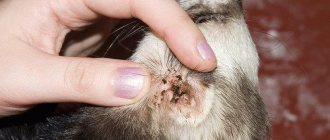The cat is one of the most beloved pets for humans. This furry friend has long been faithfully serving for the benefit of all people.
But like all living organisms on the planet, it is susceptible to various kinds of diseases that can appear at any time. One of the most common diseases is skin fungus in cats.
In general, this scourge is a general definition of skin diseases that are attacked by harmful microorganisms.
By parasitizing on the surface of the skin, microbes cause detachment of the cat's epidermis, loss of fur hairs, loss of pigment that is responsible for the cat's color, and a foul odor.
If preventive measures are not taken in time, the fungus will appear in the cat’s ears, paws, and tail.
A pet can lose weight and lose its body's defenses. Therefore, at the slightest danger, you should immediately contact a veterinarian.
What can lead to the formation of fungus
If we consider the picture as a whole, we can say that the appearance of nail fungus in cats (and not only it) occurs when the pet has physical contact with other representatives of its species.
In this case, even those cats that lead a domestic lifestyle are not insured, as they can pick up pathogens from the outdoor shoes and clothes of their owners.
This is especially true in rainy weather or in a house where there is a constant humid environment. In addition, you should be wary of minor injuries, diaper rash, etc.
The following factors can lead to the appearance of fungus:
- A young and fragile body;
- The period of lambing in a cat, when the body’s defense systems weaken;
- Decreased immunity due to the activity of a dangerous virus;
- Poor feeding;
- Carrying out immunosuppressive therapy;
- The influence of other serious diseases such as diabetes.
In some cases, diseases of this type may be asymptomatic, so they can only be detected after the hosts themselves have become infected. Very often children become the first carriers, as they most often play with pets.
Sporotrichosis
It occurs from fungal spores found in the soil. Infection occurs in two ways - through skin lesions, or by airborne droplets. Mainly cats are susceptible to this disease. The disease develops on damaged skin, on the face, and sometimes on the tail. During illness, hair falls out on the affected areas of the skin. Sometimes, sporotrichosis affects internal organs, the liver and lungs. An animal can be completely cured only if the disease has not affected the internal organs.
Potassium iodide is considered the best treatment for sporotrichosis.
In addition, ketoconazole and itraconazole give good results. If the disease has affected the internal organs, then you need to use amphotericin B. These medications are very toxic, so you do not need to use them yourself. It is recommended to consult a veterinarian, and under no circumstances attempt to treat the animal yourself.
A person can become infected with sporotrichosis through contact with inflamed areas of a cat's skin. Therefore, contact with a sick cat should be kept to a minimum, and rubber gloves should be used when caring for it.
Manifestation of the disease
Once pathogenic microbes have reached the skin surface, they immediately begin to harm the health of the cat (by releasing toxic toxins and enzymes).
Over time, this can lead to the death of the epidermis from the upper skin and the development of inflammatory processes.
If the owner notices that the first symptoms of fungus have appeared in the cat, then it urgently needs to be shown to an experienced professional.
After all, without proper care, the fungus will penetrate deeper into the pet’s body, damaging the fur structure and hair follicles.
What signs can be used to determine the presence of harmful parasites? First of all this:
- Seizures in cats - main causes, symptoms, first aid, treatment and choice of drugs (110 photos)
Polycystic kidney disease in cats - causes, diagnosis and symptoms of the disease. Treatment options and prevention of kidney disease (95 photos)
- Tartar in cats - signs of the disease and methods of fully treating tartar (125 photos + video)
- Loss of damaged pieces of fur;
- The presence of empty bald spots on the cat with clear boundaries in the head, ear area, and also on the paws;
- Restless behavior (the animal runs from corner to corner, itches and often rubs against objects);
- Scabies;
- Bad smell;
- The presence of a strange, pinpoint plaque in the ears;
- Formation of tubercles on the skin surface;
- Frequent sneezing;
- Bloody runny nose.
If the situation is neglected, the initial symptoms can develop into a severe form of the disease, which will lead to anemia, pneumonia, and complications in the gastrointestinal tract.
If the cat is still young or weakened (for example, due to lack of food), this can be fatal.
Blastomycosis
This fungus lives in soil that is contaminated with manure or bird droppings.
In addition to cats, people and dogs are also susceptible to this disease.
Very often, blastomycosis affects the respiratory system, skin, eyes and brain. This disease is very dangerous for humans. It is best treated with amphotericin B. In recent years, ketoconazole has been successfully used to treat blastomycosis. The main difficulty in treating this disease is the very high toxicity of these drugs. The likelihood of a cat infecting a person is not high, but it is better to take precautions. Contact with a sick cat is only possible while wearing protective gloves. There are also many known cases of human infection after a dog bite.
Visit the profile section of our Medical Examination forum or leave your feedback in the comments below. More opinions means more useful information, it will be useful to someone. If there are good and interesting
Types of infections
If a person suspects that his pet has picked up an infection somewhere, but is not completely sure, it is worth looking into the global web and looking for photographs of fungus in cats.
There you will also find information on various types of fungal infections:
- Aspergillosis;
- Ringworm;
- Cryptococcosis;
- Malassezia;
- Candidiasis and others.
Infections associated with the presence of fungus are a dangerous disease not only for animals, but also for people, so if there is a threat, you must urgently see an experienced specialist.
Difficulties in diagnosis and choice of direction of examination and treatment
The difficulty of diagnosing lichen lies in its insidiousness. The disease can go undetected for quite a long time, especially in long-haired cats. Kittens, young animals under one year old and pregnant cats, furry cats with weakened immune systems, animals with tumors, and pets infected with parasites are most susceptible to the disease.
To determine what kind of problem an animal has: dermatitis, allergies or lichen, you will need qualified help. It is necessary to take a number of tests and undergo an examination with your pet. Such types of research as laboratory and instrumental are common. The methods of collecting material and the type of examination will be prescribed by a veterinary clinic specialist.
Photo of fungus in cats
- Ringworm in cats - main signs, symptoms, prevention and treatment of ringworm in cats (105 photos)
Pancreatitis in cats: first symptoms, nutritional nuances and treatment options (125 photos and videos)
Subcutaneous mites in cats - first symptoms, treatment options and real photos of examples of parasite damage (110 photos + video)
Read here Lump in a cat - main symptoms, signs of a serious illness and treatment options (100 photos + video)
Help the site, share with friends 
Histoplasmosis
This fungal disease was first recorded in the central states of the United States. Fungal spores were detected in contaminated, nitrogenous soil. This land was contaminated with bat excrement, manure, and droppings. This is the most insidious fungal disease. As practice shows, in most cases it develops secretly. The main symptoms: poor appetite, fever, rapid weight loss, general weakness of the body, sometimes the cat shows signs of damage to the eyes or skin. Unfortunately, it is possible to cure a cat from histoplasmosis only in the early stages of the disease. Therefore, when you notice the first symptoms, you should immediately contact a veterinarian.











